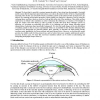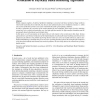15 search results - page 1 / 3 » A Predictive Light Transport Model for the Human Iris |
CGF
2006
13 years 9 months ago
2006
Recently, light interactions with organic matter have become the object of detailed investigations by image synthesis researchers. Besides allowing these materials to be rendered ...
CGF
2004
13 years 9 months ago
2004
Despite the notable progress in physically-based rendering, there is still a long way to go before we can automatically generate predictable images of biological materials. In thi...
CMPB
2007
13 years 9 months ago
2007
We show that it is possible to construct numerical models of eye colour from first principles. Our initial model assumes that the important optical interactions occur only in the a...
CGF
2006
13 years 9 months ago
2006
Within computer graphics, the field of predictive rendering is concerned with those methods of image synthesis which yield results that do not only look real, but are also radiome...
APGV
2004
ACM
14 years 2 months ago
2004
ACM
Many common materials, including fruit, wax and human skin, are somewhat translucent. What makes an object look translucent or opaque? Here we use a recently developed computer gr...


